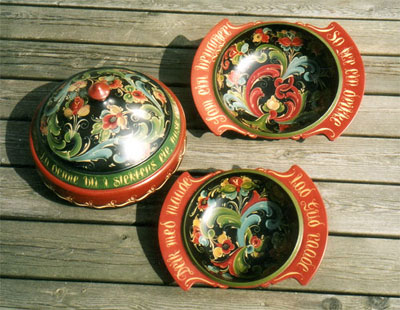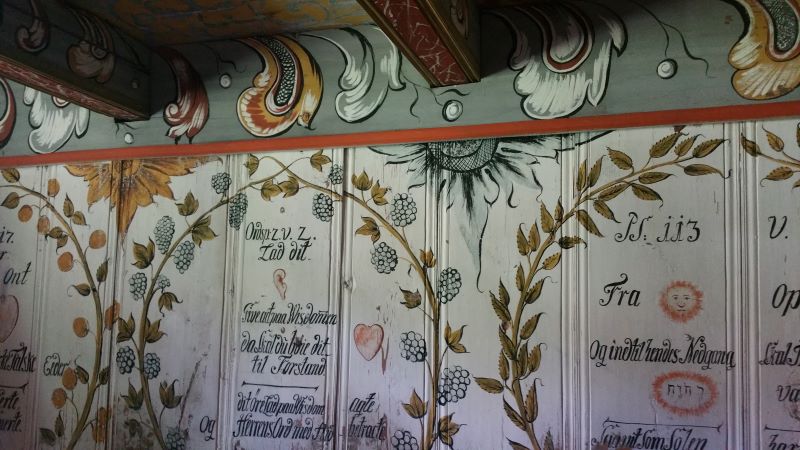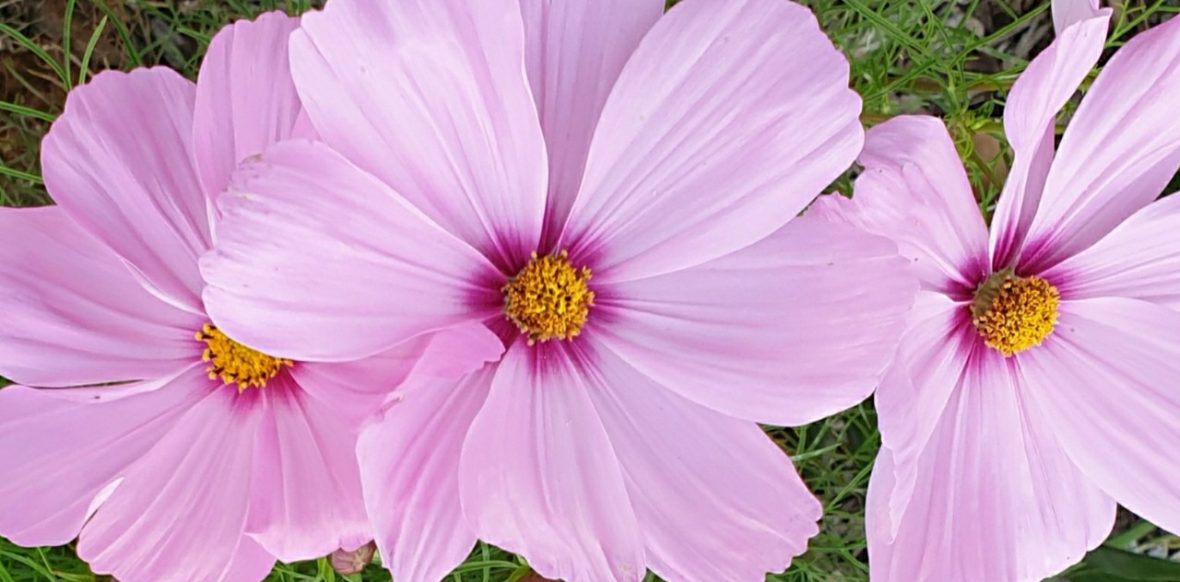Norwegian Decorative Art of Rosemaling
In traditional art, it was a custom to have a saying or Proverb decorating the border of a bowl, utensil or piece of furniture. Especially this is seen in the old decorative art of Norway, called Rosemaling.

The following words of wisdom were indicative of a social art history as they were penned by the artist of that time and reflected their thoughts and values. A time capsule of advice.
Norwegian Proverbs on Rosemaling Decorative Art

Here are a few to ponder:
– Alderen kjem ikkje aleine; han fører så mye med seg.
Age comes not alone; it brings so much with it.
–Det gror ikke til på veien mellon gode venner.
On the road between the homes of friends, grass does not grow.
–Ingen kan hjelp den som ikke vil hjelpe seg sjøl.
Noone can help someone who will not help him/herself
Too much cleverness is foolishness.
For mye klokskap er dårskap.

Curious to know more about Rosemaling, an art form that has experienced a Renaissance in America, particularly the Norwegian areas of the Mid-West?


Fascinating – and reminiscent of our barge art: https://www.google.co.uk/search?source=hp&ei=508FYIu3HsWCaYXJlKAD&q=barge+art&oq=barge+ar&gs_lcp=CgZwc3ktYWIQARgAMgUIABDJAzICCAAyAggAMgIIADICCAAyAgguMgIIADICCAAyCAguEMcBEK8BMgIIADoLCAAQsQMQgwEQyQM6CAgAELEDEIMBOgsILhCxAxDHARCjAjoICC4QsQMQgwE6DgguELEDEIMBEMcBEKMCOgsILhCxAxCDARCTAjoFCAAQsQM6CAguEMcBEKMCOgUILhCxAzoOCC4QsQMQxwEQowIQkwI6CwguELEDEMcBEK8BOgQIABADOgsILhDHARCvARCTAjoOCC4QxwEQrwEQyQMQkwJQpQ5YwTpg-V9oAHAAeACAAaABiAH3BpIBAzMuNZgBAKABAaoBB2d3cy13aXo&sclient=psy-ab
LikeLiked by 2 people
So lovely! Also, I particularly like “Too much cleverness is foolishness.”
LikeLiked by 3 people
Yes I think we have all come across those people Laurie, the ones who like to regale us with knowledge and flaunt it when it is unwarranted. It might make them look a little silly and possibly belies a hidden insecurity. Also I think this proverb alludes to intellectual snobbery, I think, and a person who ignore individuals who have many other valuable skills and attributes.
LikeLiked by 1 person
I heartily agree with you on your last thought. And those kind of people are horrible to be with
LikeLiked by 1 person
It sounds like you have come across them, Appeltjie?
LikeLike
Oh yes, haven’t we all
LikeLiked by 1 person
You bet!
LikeLiked by 1 person
An interesting and distinctive art form. How do you pronounce rosemaling?
LikeLiked by 2 people
Rose-a-mail-ing as in the english pronunciation (short a). Maling is the Norwegian word for painting and rose for flower.
LikeLiked by 1 person
Very pretty and interesting. Some words can ne understood (with your translation):
aldered, kan, hjelp, med… Hmmm.
LikeLiked by 1 person
So there is some commonality with the languages you know, Brian? That reminds me of when I was working with a French Canadian client and Pakistani/Northern Indian Physical therapist and we all noted that the Norwegian word for Pineapple was the same in the native languages (other than English). I thought it might be because it was a relatively new word only added in once they discovered pineapple in the Americas in colonial times?
LikeLiked by 1 person
Relatively new indeed. Now the words I spotted in Norwegian are “easy”. ‘Med’ is related to the German ‘mit’ and the Dutch ‘met’. kan is easy. ‘hjelp’ is a fun reminder of ‘help’.
As you can tell I love languages.
LikeLiked by 1 person
Me too! I loved learning Japanese, buts of German, and later Danish and Norwegian. I tried to learn Polish but it was impossible to reproduce the sounds using online programs. It is surprising the number of common words across languages.
LikeLiked by 1 person
You have learnt japanese… ??? Wow. I am impressed. I am learning a bit of Hokkien, a straights Chinese dialect in Singapore and malaysia.
All European languages have common roots tracing back to the Caucase mountains. Some Hindi words are similar. But Slavic? They must have separated very early…
Do you know platforms to learn languages?
LikeLiked by 1 person
I use Duolingo and Future learn but for Norwegian I have friends who are native speakers and we learn together from time to time. I try to use it on social media when chatting to the Norwegians in Norway or the Danes in Denmark. The Danish pronounciation is difficult so I switched to just concentrating on Norwegian – as the Danes understand that too.
Japanese is not a difficult language at all. It is taught in many schools here. That started in the 70’s and my high school was the pilot school. At that time, there was loads of Japanese coming to visit Australia for their short vacation. Direct flights and the fact that we have cute and cuddly animals like the Koalas helped foster that influx. Responding to that, the education system encouraged Japanese as a language in schools. Now the kids learn it from year 3 in a very simple social way – cultural aspects, food etc. In upper primary and high school years, it gets serious. The characters are very logical in the basic alphabet but they get much tricky in the senior years. I regret that I had to give up language when I went to senior school as they did not offer Japanese…. I still remember a lot of what I learnt way back then. It sticks.
LikeLiked by 1 person
Compliments on japanese. My Frog compatriots are lousy on languages. I was lucky to learn so many languages on site. Later on, when I got to France my French teachers of English hated my guts because I spoke much better English than they did. Accent-wise in particular. 🤣 Ay do not have ze Frrench a-ksent… It was fun.
I made a note of those sites. I’ll see whether they have options that might interest me.
“Good Dayy” 😉
LikeLiked by 1 person
Ah well the French seem to be the exception in regard to my previous comment on the Europeans being good at languages. After all the Olympics and Eurovision still has to have French translations – even the Germans cope without that…..
A little bit of French snobbery perhaps????
Good dayy…. well we would nomally say G’day. Australians shorten everything. It must be the heat, it takes all our energy and we are so casual about languages.
LikeLiked by 1 person
It is probably a part snobbery. PLus the fact that french up to the end of the 19th century was the language of higher class the world over. Plus typical French Idiosyncracy: English is only taught in secondary school and almost exclusively by French teachers. Unions. So they may be very good in vocabulary, grammar, English lit, but ze verry “teechars” have a lousy accent…
G’day now. 😉
LikeLiked by 1 person
Oh and Slavic, yes definitely must have separated early – it is interesting isn’t it – Hungary, Slavic countries and randomly Finnish tucked in that group.
LikeLiked by 1 person
Just remembered. The word ‘tak’ in Scandinavian I have always found a good example: tak, (viel) dank, dank (u), thank (you) all the same word.
LikeLiked by 1 person
Tusen takk, ( norwegian) tusind tak ( Danish) tak så mycket ( swedish) Thanks very much in england. And now you say it the german equivalent is similar I guess. Viel????
LikeLiked by 1 person
I gather that tusen, tusind mean ‘thousand’? (yeah!)
mycket could be much? Så? (Found the key!) no idea.
German would go Danke (thank) schön (nice, nicelyO or Viel (a lot, much, many) Dank. There probably is a Sandinavian equivalent? In Dutch it is Dank U (U=formal you) or dankje (je=informal you, between friends)
LikeLiked by 1 person
Tusind/tusen is exactly that – thousand. So a thousand thanks or thank (you) very much. Viel – would have the equivalent in Scandi languages as veldig! Pretty similar. Så is simply so… Takk så mycket – thanks so much. No wonder Scandis are so good at other European languages. The common roots.
Someone told me that Dutch sounds like Danish German and French combined, and perhaps that is so.
LikeLiked by 1 person
Sååååååå. 😉 yes, many common roots. Dutch was in fact a germanic dialect until late. Then pronunciation kicks in the g is pronounced like the Spanish J. Maybe as a result of the Spanish invasion. “Så” ‘dag’ (Day, or tag) is pronounced like the Arabic Kh… Complicated…
Now Dutch also has a lot of French vocabulary, as french was the Dutch elite’s favourite language at one time.
Love those chats. Cheers.
LikeLiked by 1 person
Yes indeed. Linguistics is fun. Ypu mentioned two things about Dutch. G pronounced as j..same in Scandinavian and så like Arabic kh. Så in Norwegian is sometimes pronounced as shaw as in the word shawl; and then in swedish the kj sounds which is like a whistled q sound in Norwegian a sha sound. Similar but different. Interesring how French was absorbed into Dutch. And as I think we have spoken about before: The Frisians in North Netherlands where the dialect is much more like Scandinavian than Dutch.
LikeLiked by 1 person
Actually, I meant så in lieu of ‘so’. The J sound in Sapnish is similar to guttural sounds in Arabic. Probably comes from the Arabic presence in Spain for centuries.
Yes ‘Ssss’ is often transformed into shhh. Some regions of France used to pronounce sss as shhh.
Yes, you mentioned frisians… Accents and pronunciations start in the family. Children tend to adopt their parents voices, vocabulary and accents. The farther away you go form the family to the border, the farther away the speech patterns…
LikeLiked by 1 person
Yes they would naturally adopt their parent’s voices until they get to school, don’t you think? Then peer pressure and the influence of being with other children also changes their accents?
LikeLiked by 1 person
Of course. Though the voice you learn before 4 stays with you. Now when I talk on the phone to my eldest brother it startling. Sometimes I feel I’m listening to my father…
Outside the immediate circle? When I’m with Americans I speak “Murrican”. With Brits? I can probably outposh the best of them…
Need to travel Down under to pick up the local style… Though I must confess “kiwis” have been the hardest for me to understand…
G’day…
LikeLiked by 1 person
G’day mate! It is only said when first meeting and not on leaving – when we depart a location or person we would say: ‘see ya’, or ‘catch ya later’ or even ‘take care’. Very informal and casual. The odd ‘bye’ but I would rarely if ever hear someone say the full word, ‘Goodbye.’ In Australia, that would seem quite stilted and unusual.
I didn’t know that four years was a significant age. Sounds like you can get your ear around most accents. But the Kiwis…. it is quite an effeminate accent, I think. The accent that I can’t understand is the Scottish brogue or occasionally an Irishman – I have to really concentrate even though they are speaking my language. Aural language skills are more difficult than the skills necessary for deciphering the written word in a foreign language.
LikeLiked by 1 person
Like I said, accents are fascinating. I went to Grad school in the South of the US. “Alabamer”. I was already bilingual, but “Ah swear”, first three weeks, Ah couldn’t unnershtand a word they saiiid. Lord, Lord!” A different language. Then I learnt it.
As for 4 years, they are critical for a child’s development, when they learn all major skills. But most people don’t have memories of anything before the age of 4. Freud had his views on the matter.
LikeLiked by 2 people
I have one or a few very vague memories of being close to 4 years old but I take your point. Absolutely critical years.
LikeLiked by 2 people
Totally, we learn to walk, speak, eat, sing, etc… And lose access to those memories.
LikeLiked by 2 people
Very wise words — and all so true!
Thanks for sharing this!
LikeLiked by 2 people
Lovely, thank you Donna! I do enjoy reading quotes!
LikeLiked by 1 person
Lovely words
LikeLiked by 2 people
Thanks so much! Where are you from Sowmya? I am in Australia.
LikeLike
I live in Toronto, Canada
LikeLiked by 1 person
Okay! Do you follow Sandy’s blog?
LikeLike
No. Send me the link. Will follow
LikeLike
Thesandychronicles.blog
LikeLike
Thank you. Will check it out
LikeLike
I have a small bowl with a lid painted in this style. It was given to me by my Norwegian penfriend when I was maybe 12 or 13, so it’s probably regarded as vintage now. It’s quite beautiful and I treasure it. It doesn’t have a saying on it though.
LikeLiked by 2 people
Wow! You do! Lucky you. It would be vintage! You must share a photo of it in a post. Do you know who the artist might be? Is it signed?
LikeLike
No, it’s not signed but it has a label on the base. I can’t read it though, it’s quite worn.
LikeLike
It is most likely a tourist piece from a Husfliden store. They sell Norwegian handicrafts.
LikeLike
I think so too. It’s quite lovely.
LikeLiked by 1 person
Yes, you ar allowed to foster your favourite skill. I give my permission.
Heh heh ..
LikeLiked by 2 people
Awesome. Do you use instagram at all?
LikeLiked by 1 person
I would; but it won’t let me join. I think it might be because it’s owned by Facebook ..
LikeLiked by 1 person
Are you banned on that platform?
LikeLiked by 1 person
I believe I must be. No notice of such; but the fact that I CANNOT sign up seems to indicate such.
LikeLiked by 1 person
Interesting. Even though you have changed ISP’s when you moved?
LikeLiked by 1 person
Yup.
LikeLike
Whoa.
LikeLike
This is fascinating, Amanda! These are beautiful – and to think they contain wisdom & well-wishes of the artist.
My favourite is “On the road between the homes of friends, grass does not grow” – so poetic!
LikeLiked by 2 people
It is s good one I agree.
LikeLiked by 1 person
Ah you see the connection, Derrick. Yes each region of the world has its own version of folk art. Norway’s is Rosemaling. Germany has Bauernmalerei and England: Barge or Canal Boat Art.
LikeLiked by 1 person
The art is gorgeous. I like that it includes proverbs.
LikeLiked by 2 people
I think so too, Peggy. And I am not surprised that you enjoy the proverbs.
LikeLiked by 1 person
Like Derrick I spotted the similarities with our narrowboat barge art, but that doesn’t have the sayings. My favourite is ‘On the road between the homes of friends, grass does not grow’
LikeLiked by 2 people
It is a nice saying, Sarah, isn’t it? Indicates the depth of the bond that friendship can bring.
LikeLiked by 1 person
A beautiful style! And I love the quote “On the road between the homes of friends, grass does not grow.”
LikeLiked by 2 people
Thank you, Dorothy. That saying about no grass growing between the road between friends seems to be the most popular saying amongst readers. I suppose we can all relate to it and it would be fitting to have on a serving bowl or furniture piece, I think.
LikeLiked by 1 person
Yes it would. I’m afraid the grass got rather long this year…
LikeLiked by 1 person
It can’t be helped. This year was one of anomalies.
LikeLiked by 1 person
The colours are so vibrant & the patterns so sweet, I love the language. There is no grass on the path between the house & the chook pen or the horses paddock, lol, does that count. haha. Have a wonderful day my friend.
LikeLiked by 2 people
It absolutely counts, Linda. Animals make the best friends. Their companionship is something I do not like be without… ever….
LikeLiked by 1 person
I’ve always admired this art form! So beautiful! Thank you for sharing!
LikeLiked by 2 people
You are familiar with it Aletta?
LikeLike
I have seen it at a friend’s house long ago!
LikeLiked by 1 person
She must have been Norwegian! Was that in Norway?
LikeLike
Not at all. She was married to a German guy. Not sure where came from. Perhaps even from his parents.
LikeLiked by 1 person
A well travelled piece. How interesting.
LikeLike
Indeed
LikeLiked by 1 person
As you well aware that I have always loved Rosemaling. I began loving it seeing it on some of the city homes in Germany. I love those old buildings and the architecture. My favorite of your quotes is “Age comes not alone; it brings so much with it.” I so agree. I would never go back to my younger years.
LikeLiked by 1 person
That is true, Marlene. Age is not always fun, but the emotional pain of my younger years makes me agree with you 100%.
Another benefit of growing up in Germany – being exposed to those artisitic and historic influences.
LikeLiked by 1 person
“On the road…” quote. I really like that one. The artwork is awesome.
Art
LikeLiked by 1 person
That seems to be the most popular one, Art.
LikeLike
wow interesting, that decoration reminds me of art in my place used to be
LikeLiked by 2 people
Is that right, Gabriel? It has so many links with European art of the past. Was it painted in your home?
LikeLiked by 1 person
I love the beautiful artwork and the proverbial sayings-My favourite was the one of’On the roads between the homes of friends, the grass does not grow’. I think it is a perfect way of portraying just what a good friendship looks like.Thank you.
LikeLike